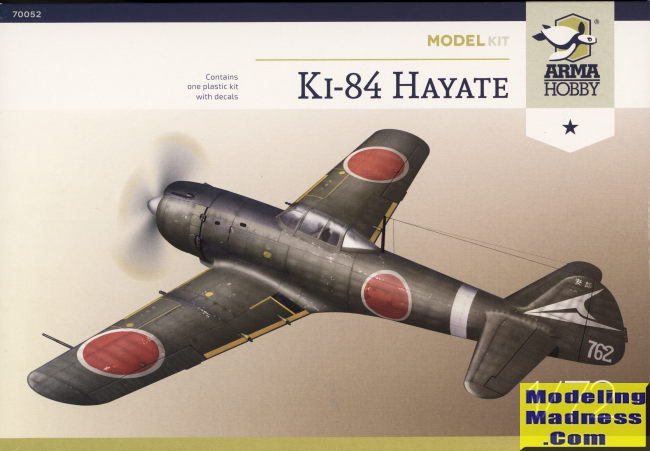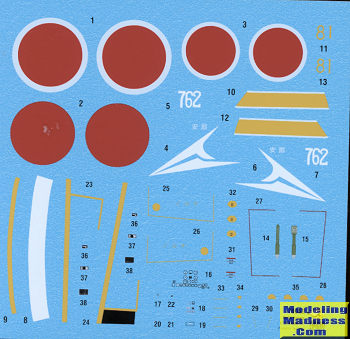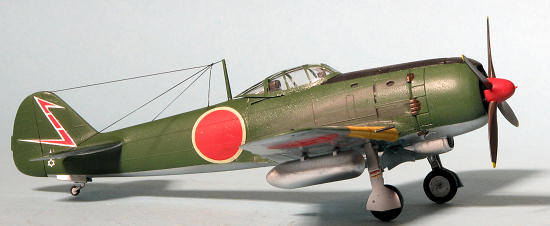
Arma Hobby 1/72 Ki-84 Hayate
| KIT #: | 70052 |
| PRICE: | $27.00 delivered from Poland |
| DECALS: | Two options |
| REVIEWER: | Scott Van Aken |
| NOTES: |

| HISTORY |
Design of the Ki-84 commenced in early 1942 to meet an Imperial Japanese Army Air Service requirement for a replacement for Nakajima's Ki-43 Hayabusa, just entering service. The specification recognised the need to combine the manouverability of the Ki-43 with performance to match the best western fighters and heavy firepower. The Ki-84 first flew in March 1943. Although the design itself was solid, the shortage of fuel and construction materials, poor production quality, and lack of skilled pilots prevented the fighter from reaching its potential. A total of 3,514 were produced.
The Ki-84 addressed the most common complaints about the popular and highly maneuverable Ki-43: insufficient firepower, poor defensive armor, and lack of climbing power. The Ki-84 was introduced with two 12.7 mm (.50-in) machineguns and two 20 mm cannons, a considerable improvement over the single 7.7 mm and single 12.7 mm machine guns of the Hayabusa. Defensive armor offered Hayate pilots better protection than the unsealed wing tanks and light-alloy airframe of the Ki-43. In addition, the Ki-84 used a 65 mm armor-glass canopy, 13 mm of head and back armor, and multiple bulkheads in the fuselage, which protected both the methanol-water tank (used to increase the effectiveness of the supercharger) and also the centrally located fuel tank.
It was the powerplant that gave the Hayate its high speed and prowess in combat. Derived from the Homare engine common to many Japanese aircraft, the Hayate used a direct-injection version of the engine, using water injection to aid the supercharger in giving the Ki-84 a rated 2,000 hp at takeoff. This combination—in theory, at least—gave it a climb rate and top speed roughly competitive with the top Allied fighters of the late Pacific theater, the P-51D Mustang and P-47D Thunderbolt (with top speeds of 433 and 426 mph, respectively). Initial Hayate testing at Tachikawa in early summer 1943 saw test pilot Lt. Funabashi reach a maximum level speed of 634 km/h (394 mph) in the second prototype, but after the war a captured example was tested by the U.S. Army using high-octane fuel and achieved a speed of 690 km/h (430 mph).
The complicated direct-injection engine, however, required a great deal of care in construction and maintenance and, as the Allies advanced toward the Japanese homeland, it became increasingly difficult to support the type's designed performance. Compounding reliability issues was the Allied submarine blockade which prevented delivery of crucial materials for construction of components such as the landing gear. Many Hayates consequently suffered strut collapses on landing.
| THE KIT |
![]() We have not lacked a nice 1/72 Ki-84, with Hasegawa producing one that is not
only accurate in shape, but also one of Hasegawa's last kits with raised panel
lines. However, we are talking about a kit that is 30+ years old, with a very
basic and inaccurate cockpit, along with a lack of fine detail. Some of this was
'fixed' by the RS Models kits, but those have been damned by their difficult
build qualities.
We have not lacked a nice 1/72 Ki-84, with Hasegawa producing one that is not
only accurate in shape, but also one of Hasegawa's last kits with raised panel
lines. However, we are talking about a kit that is 30+ years old, with a very
basic and inaccurate cockpit, along with a lack of fine detail. Some of this was
'fixed' by the RS Models kits, but those have been damned by their difficult
build qualities.
Arma Hobby is fairly new company, but they have a positive following. This is the second kit of theirs I have bought with the first being the P.7a, which I have yet to build. There is a single grey and single clear sprue. The kit detailing is excellent and as one expects from modern kits, there are a lot of parts. Many of the smaller ones have fine detail bits that require some finesse to not only remove from sprues but to properly attach. However, when one wants increased small detail, that is the price one pays.
A nicely detailed cockpit is provided with the control column and flap handle being installed from beneath the floor. The seat mount is incorporated into the rear bulkhead and has to be bent to shape. Decals are provided for the main instrument panel and for the lap belts. There is good sidewall detail on which one attaches a few components.
Moving to the engine we are provided both banks along with a split piece for the pushrods. The engine attachment points in the fuselage half are quite positive. Before closing these halves, the tail wheel is installed. Wings are a lower section with two upper halves. If one wants to install pylons for drop tanks or bombs, holes must be opened in the lower wing.
Then one attaches the wing and horizontal stabs to the fuselage. There is are upper and lower cowling pieces that also needs to be glued in place. The forward cowling is separate and if doing one of the markings options, one may wish to keep this unattached until after painting.
An interesting feature is the provision for two different upper fuselage pieces. One is for an open canopy and the other for closed. Main landing gear legs are quite scale and each side needs to be fully assembled along with the doors before attaching to the fuselage. If not installing bombs or drop tanks, the last steps are the exaust and cowl flaps followed by the prop and spinner.
 The instruction booklet is in color and offers a variety of paint options.
The two options are both in olive green upper with olive grey undersides with
yellow forward wing ID sections. One is the box art plane from 112 Sentai with a
white spinner. The other is from 72 Sentai with yellow spinner and yellow
forward cowling. This option is the one for which you may wish to leave off the
forward cowling until after painting. Decals are nicely printed by Techmod.
Something to keep in mind is that often the underside of the Ki-84 was unpainted
metal and not painted grey. The last
The instruction booklet is in color and offers a variety of paint options.
The two options are both in olive green upper with olive grey undersides with
yellow forward wing ID sections. One is the box art plane from 112 Sentai with a
white spinner. The other is from 72 Sentai with yellow spinner and yellow
forward cowling. This option is the one for which you may wish to leave off the
forward cowling until after painting. Decals are nicely printed by Techmod.
Something to keep in mind is that often the underside of the Ki-84 was unpainted
metal and not painted grey. The last
 1/72 Hasegawa kit I built had the
undersides aluminum. Here is a photo so you can make your own choice. Note also
that some aircraft had green prop blades and the interiors could be aotake, dark
green, or unpainted metal.
1/72 Hasegawa kit I built had the
undersides aluminum. Here is a photo so you can make your own choice. Note also
that some aircraft had green prop blades and the interiors could be aotake, dark
green, or unpainted metal.
| CONCLUSIONS |
It looks like a very nice kit. Probably not for beginners due to the inserts and small parts, but something that those with mid-level experience should be able to make into a very nice model.
November 2022
Copyright ModelingMadness.com. All rights reserved. No reproduction in part or in whole without express permission from the editor.
If you would like your product reviewed fairly and fairly quickly, please contact the editor or see other details in the Note to Contributors.